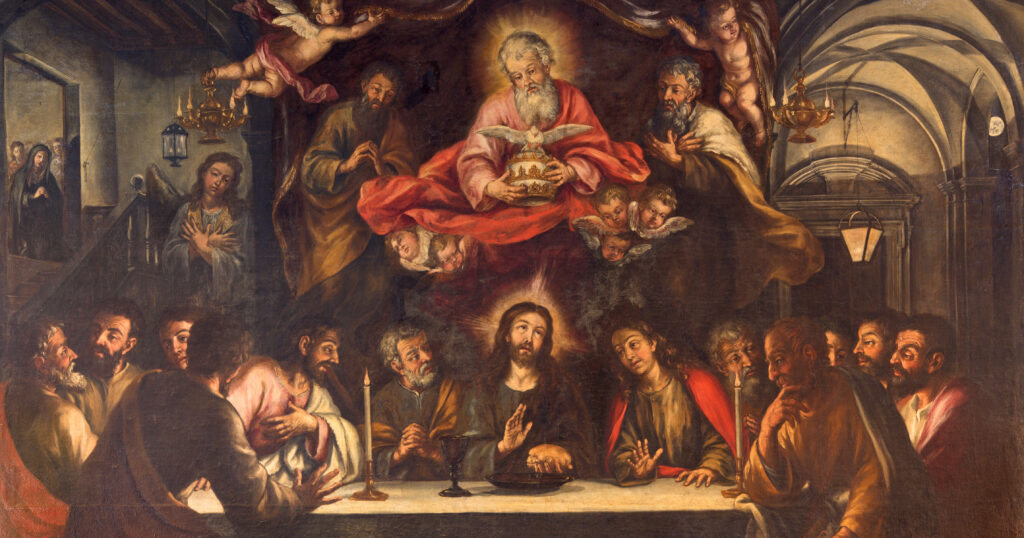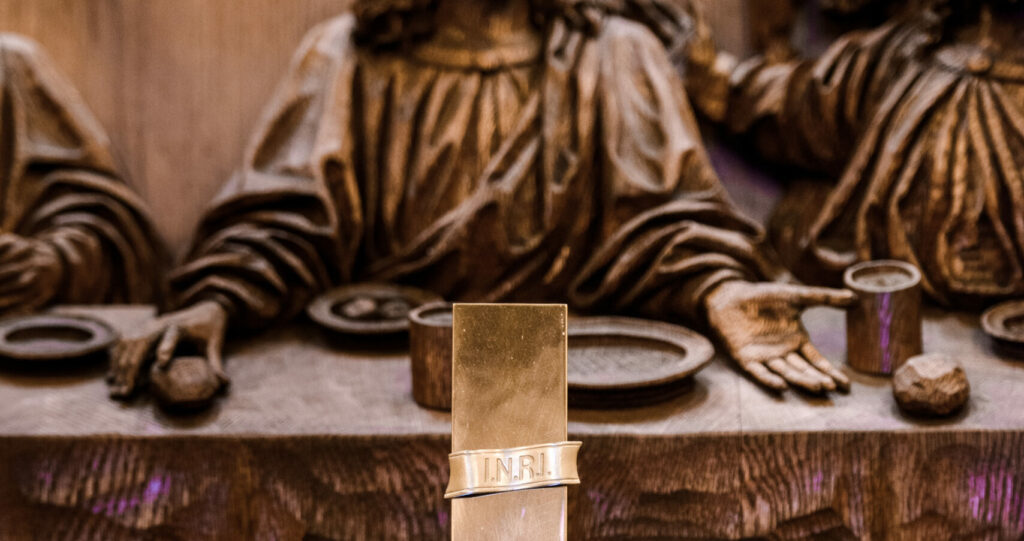By Arthur A. Just
On the Mount of Transfiguration, heaven and earth came together in the glorified body of Jesus. Peter, James and John, three of Jesus’ disciples, came up the mountain with Him for this encounter with Moses and Elijah, two heavenly beings. In this communion between heavenly and earthly bodies around the dazzling white body of Jesus, we see a picture of what happens in the Divine Service around the bodily presence of Jesus in the liturgy of the Word and the Lord’s Supper.
In this glorious encounter, Peter, James and John were privy to the heavenly conversation of Moses and Elijah. What was this heavenly conversation? Moses and Elijah, descending from heaven, surely spoke about the exodus Jesus was about to fulfill in Jerusalem: His suffering, death, resurrection and ascension. For this is the song of all heaven: praises to the Lamb who was slain and raised again (Rev. 5). This is what our liturgies should always be proclaiming — that the glorified and ascended Christ is present among us with His wounds to offer us the gifts of His exodus: forgiveness, life and salvation.
When we come to the Divine Service to hear the Word of Jesus and to eat His body and blood, we are entering into the heavenly Jerusalem. And so, we are not alone in our communion with the bodily presence of Jesus. As our liturgy says, we worship “with angels and archangels and the whole company of heaven.” That “company of heaven” includes all the saints who have died in Christ and now live with Him.
At the Lord’s Supper, we join a world outside ourselves: We receive gifts from heaven in the flesh of Jesus. We submit ourselves to the great mystery that heaven comes to earth through the bodily presence of our Savior. We sometimes think of heaven abstractly, as somewhere “up there.” But heaven is where Jesus is — where His Word and His gifts are received by faith. Because Jesus is present among us in the gifts of Word and Sacrament, heaven itself is present among us. Our worship is the world of “angels and archangels and the whole company of heaven.” These words in our liturgy are from Hebrews 12:22–24:
But you have come to Mount Zion and to the city of the living God, the heavenly Jerusalem, and to innumerable angels in festal gathering, and to the assembly of the firstborn who are enrolled in heaven, and to God, the judge of all, and to the spirits of the righteous made perfect, and to Jesus, the mediator of a new covenant, and to the sprinkled blood that speaks a better word than the blood of Abel.
The approach to Mount Zion, into God’s presence, has already begun here on earth. Mount Zion, the city of the living God, the heavenly Jerusalem, is not a specific place in Israel — it is wherever Christ is present according to both His divine and human natures. What did Hebrews’ first-century hearers think when they heard this passage? They knew that “Mount Zion” meant the place where Christ speaks for His Father and acts for His Father. That place is the liturgy, where Christ’s Word brings purification of sins through preaching and the Lord’s Supper. As we enter God’s presence in Jesus, heaven on earth begins already now in the church’s eucharistic life, even as it will reach its consummation when we fully experience Christ’s presence at the heavenly feast. As we learn from the Mount of Transfiguration and Mount Zion, the liturgy of Word and Sacrament is the moment when heaven comes to earth.
Our liturgy uses another New Testament reference to describe this reality of heaven on earth in the hymn we sing during the Easter season: “This Is the Feast.” The content of this great hymn comes from St. John’s Revelation. This “hymn of all creation” that we now sing as the people of God is also the song of the hosts of heaven, of the saints standing by the sea of glass with harps of God in their hands, the song of Moses and the song of the Lamb that signals victory in the battle with the beast (Rev. 15:2–5). It is also the song of the multitude at the marriage supper of the Lamb (Rev. 19:1–10). In this hymn of victory, heaven and earth are joining together, singing, “blessing, honor, glory, and might be to God and the Lamb forever.” And heaven and earth also sing together, “Amen!” Our communion with heaven here on earth is beautifully stated in the last stanza of the hymn: “For the Lamb who was slain has begun His reign. Alleluia.” The beginning of the Lamb’s reign is the ongoing victory feast of Word and Sacrament that Christians have been celebrating since that first Pentecost, and continue to celebrate even now.
For many years, while speaking about the historic liturgy in our congregations, I would tell people about “the angels and archangels and the whole company of heaven.” It was surprising how many of them had never heard the full meaning of these words — how at every Lord’s Supper my wife and I remember her sister who died tragically at the age of 22. How we remember those who have recently died in our acquaintance. How they are with us in Christ. How our voices here on earth join their voices in heaven as we sing, “Holy, holy, holy, Lord God of Sabaoth, heaven and earth are filled with Thy glory.” How in the communion of saints we have this mystical union with Christ and with all the saints who have died and now dwell in Christ. How their fight is over, their suffering has ceased, and, like us, they are awaiting the resurrection of the body. How, as we wait for the Lord to come again, we are still in communion with them. How the same Christ in whom they dwell also dwells with us in His body and blood. How Christ, whose presence among us brings all of heaven with Him, is the object of the worship of heaven and earth. For Jesus’ “sprinkled blood … speaks a better word than the blood of Abel,” because “worthy is Christ, the Lamb who was slain, whose blood set us free to be people of God. … For the Lamb who was slain has begun His reign. Alleluia.”





I hate to disagree with Dr. Just, but I don’t think heaven comes to earth on Sunday morning. Nor do I think departed Christians are present during Communion. Hebrews talks about Mt. Zion and Mt. Sinai, but I think it is saying we are forgiven by the Gospel instead of being condemned by the Law. Actually being in heaven is something we have to die to experience. Communion is a foretaste, not the feast to come. And the reference to “all the company of heaven” is from a (not divinely inspired) prayer that simply says we praise God in the same way that angels and saints praise him in heaven. And Luther said in the Large Catechism that the “communion” of saints means that the Church is a community, not that there is some mystical link between the living and the dead. The Lord’s Supper gives us Christ’s body & blood, along with forgiveness, life, and salvation–here on earth. The liturgy does not join heaven and earth except in a metaphorical sense. Christ blesses us with the Word and sacraments, but we are still on earth, not in heaven. Just my two cents.
Thank you, Dr. Just!
Good morning,
Heaven and earth…
It’s all one.
Or it’s not.
Just thinking… pondering.
Theresa
Wow! How unworthy I felt as I read
what you wrote. I, like others, repeat the words over and over as we worship in church, but somehow forget how magnificant the meaning, of what is said, really is. I thank God for his Son and for the hope, love and forgiveness that we receive. I need to focus thankfully on what the Lord has done .
What is known about the painter of the painting used in this article?
RE: “… the place where Christ speaks for His Father and acts for His Father. That place is the liturgy …” (emphasis added).
“… where Christ speaks for His Father and acts for His Father”?
Hasn’t Christ always and everywhere spoken and acted entirely according to his Father’s will? Jesus said, “I and the Father are one” (John 10:30) and, “Whoever has seen me has seen the Father” (John 14:9).
“… the liturgy”? Which one?
Is it only as we follow a particular ritual in a particular place at a particular time —
• That Jesus will be our shepherd (Ps. 23, John 10:11-18), acting to guide and protect us?
• That we may ask for, receive, and be confident of God’s forgiveness (Ps. 32:5, Col. 1:14)?
• That the Holy Spirit will remind us of what Jesus spoke (John 3:8, 14:26)?
• That Jesus will be among two or three gathered in his name (Matt. 18:20)?
• That the word of Christ will live in our hearts (Rom. 10:6-9)?
• That we may edify and encourage one another with Jesus’ own words (Col. 3:16, Luke 10:16)?
• That Jesus will respond helpfully to our prayers (John 14:13, 1 Tim. 2:8)?
• That the entire Godhead will be near to us for our benefit (Jer. 23:24; Psalm 139; Acts 7:48, 17:24; Phil. 4:5; Matt. 28:20; Heb. 13:5)?
Those of us who go to church weekly typically spend 99% of our time outside formal congregational worship. So is it not through Jesus’ continuous mediation that we have, wherever we are, ongoing access to the throne of grace (Heb. 4:16)?
“The steadfast love of the Lord never ceases;
his mercies never come to an end” (Lam 3:22 ESV).